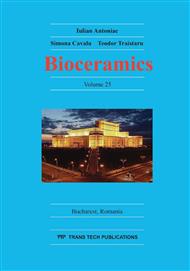p.205
p.211
p.215
p.222
p.229
p.233
p.239
p.245
p.249
Biomimetics and Marine Materials in Drug Delivery and Tissue Engineering: From Natural Role Models to Bone Regeneration
Abstract:
During the last two decades learning from nature has given us new directions for the use of natural organic and inorganic skeletons, drug delivery devices, new medical treatment methods initiating unique designs and devices ranging from nanoto macro scale. These materials and designs have been instrumental to introduce the simplest remedies to vital problems in regenerative medicine, providing frameworks and highly accessible sources of osteopromotive analogues, naofibres, micro and macrospheres and mineralising proteins. This is exemplified by the biological effectiveness of marine structures such as corals and shells and sponge skeletons to house self-sustaining musculoskeletal tissues and to the promotion of bone formation by extracts of spongin and nacre seashells. Molecules pivotal to the regulation and guidance of bone morphogenesis and particularly the events in mineral metabolism and deposition similarly exist in the earliest marine organisms because they represent the first molecular components established for calcification, morphogenesis and wound healing. It emerges that bone morphogenic protein (BMP) molecules-the main cluster of bone growth factors for human bone morphogenesis-are secreted by endodermal cells into the developing skeleton. Signalling proteins, TGF and Wnt-prime targets in bone therapeutics-are present in early marine sponge development. Furthermore, ready-made organic and inorganic marine skeletons possess a habitat suitable for proliferating added mesenchymal stem cell populations and promoting clinically acceptable bone formation. In this paper we review the nature, morphology and extent of this association and use of these structures for bone grafts, drug delivery and extracts such as proteins for regenerative medicine. As an example, in human biology a study of matrix vesicles will teach us valuable lessons on how proteins are captured and coated; and how the vesicle is able to dock and fuse with their target. We will describe significant technological trends aimed at producing delivery vehicles using natural-origin soft and hard organized matter; fabricated into capsules and cell-delineated assemblies.Therole model for this specific biomimicry is the filtering microskeleton of Foraminifera. We will outline new selected strategies based on our and others works for the engineering of new bone, based on biomimicry themes using these bioceramics building blocks.
Info:
Periodical:
Pages:
229-232
Citation:
Online since:
November 2013
Authors:
Price:
Сopyright:
© 2014 Trans Tech Publications Ltd. All Rights Reserved
Share:
Citation:


